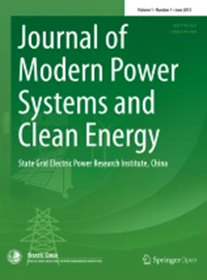Operational Coordination Optimization of Electricity and Natural Gas Networks Based on Sequential Symmetrical Second-Order Cone Programming
IF 5.7
1区 工程技术
Q1 ENGINEERING, ELECTRICAL & ELECTRONIC
Journal of Modern Power Systems and Clean Energy
Pub Date : 2024-10-04
DOI:10.35833/MPCE.2023.000750
引用次数: 0
Abstract
The variable and unpredictable nature of renewable energy generation (REG) presents challenges to its large-scale integration and the efficient and economic operation of the electricity network, particularly at the distribution level. In this paper, an operational coordination optimization method is proposed for the electricity and natural gas networks, aiming to overcome the identified negative impacts. The method involves the implementation of bi-directional energy flows through power-to-gas units and gas-fired power plants. A detailed model of the three-phase power distribution system up to each phase is employed to improve the representation of multi-energy systems to consider real-world end-user consumption. This method allows for the full consideration of unbalanced operational scenarios. Meanwhile, the natural gas network is modelled and analyzed with steady-state gas flows and the dynamics of the line pack in pipelines. The sequential symmetrical second-order cone programming (SS-SOCP) method is employed to facilitate the simultaneous analysis of three-phase imbalance and line pack while accelerating the solution process. The efficacy of the operational coordination optimization method is demonstrated in case studies comprising a modified IEEE 123-node power distribution system with a 20-node natural gas network. The studies show that the operational coordination optimization method can simultaneously minimize the total operational cost, the curtailment of installed REG, the voltage imbalance of three-phase power system, and the overall carbon emissions.求助全文
约1分钟内获得全文
求助全文
来源期刊

Journal of Modern Power Systems and Clean Energy
ENGINEERING, ELECTRICAL & ELECTRONIC-
CiteScore
12.30
自引率
14.30%
发文量
97
审稿时长
13 weeks
期刊介绍:
Journal of Modern Power Systems and Clean Energy (MPCE), commencing from June, 2013, is a newly established, peer-reviewed and quarterly published journal in English. It is the first international power engineering journal originated in mainland China. MPCE publishes original papers, short letters and review articles in the field of modern power systems with focus on smart grid technology and renewable energy integration, etc.
 求助内容:
求助内容: 应助结果提醒方式:
应助结果提醒方式:


